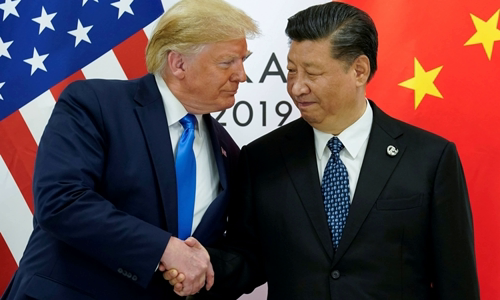Washington will abandon its plans to impose taxes later this week, in return, China will increase purchases of agricultural products and other US goods and services.
After nearly two years of confrontation in the trade war, the US - China on December 13 announced that they had reached a first phase agreement and are expected to sign the document in early January, after legal review and certainty. The English and Chinese versions have comparable languages.

US President Trump (left) and Chinese President Xi Jinping at G20 in Japan in June Photo: Reuters
Beijing has agreed to increase imports of at least US $ 200 billion in US goods and services over the next two years. This will be a leap in US exports to China. In return, the US will not impose a 15% tax, which is scheduled to take effect on December 15 for US $ 160 billion of Chinese goods and halve the tax rate from September 1 to US $ 120 billion of goods. China to 7.5%. However, the US 25% tax on US $ 250 billion of Chinese goods remains the same.
China pledged to increase US farm product purchases by US $ 32 billion in two years. As such, they will buy about 40 billion USD a year, compared with 24 billion USD in 2017.
Trump has asked China to buy US $ 50 billion of American farm produce annually. US Trade Representative Robert Lighthizer said China agreed to do its utmost effort to raise US $ 5 billion annually, aiming to get closer to the US $ 50 billion target. China is also committed to reducing non-tariff barriers on agricultural products such as poultry, seafood and feed additives as well as approving biotechnology products.
"It was an extremely important first step in our relationship," Lighthizer said. "China is really committed to taking substantive steps within a reasonable amount of time."
China's Agriculture Vice Minister said it would import additional US wheat, corn and rice without giving any specific explanation. China is not a major US customer in these commodities, but in recent years, it ranked third or four of the largest buyers of US spring-grown wheat. China used to be in the top 5 US corn customers in 2011-2014 but then reduced trading.
Soybeans accounted for half of the amount of Chinese farm produce purchased in 2017. However, demand has decreased due to African swine cholera.
When asked about Trump's $ 50 billion figure, officials in Beijing said on December 13 that details would be revealed later.
Some American farmers said they were waiting for more. "Will China deliver on its commitment?" Said Burton Eller, a cow farmer who heads the National Grange agricultural advocacy group.
"Do they have a clear black and white paper commitment they will buy every single one of this time around or what kind of product they need?", He added.
In addition to the agricultural contract, the agreement requires China to provide stronger legal protection for patents, trademarks, and copyrights, including improving criminal and civil procedures to combat piracy. online rights, pirated goods and counterfeit goods.
China pledged to abandon the form of forcing foreign companies to transfer technology to Chinese businesses to gain access to the market. They also agreed to restrict domestic businesses from buying foreign technology.
In the monetary field, China is committed to not devaluing its currency to compete and not using exchange rates to serve its goodwill. China has pledged this to the 20 major economies (G20) for many years.
A senior Trump administration official said the currency deal was based on the terms of the U.S.-Mexico-Canada Agreement, requiring the three countries to disclose monthly data on international reserves and market interventions. foreign exchange market, quarterly balance of payments (recording a country's economic transactions with the rest of the world) and other public reports to the International Monetary Fund (IMF).
With the new agreement, US companies will improve access to China's financial services markets, including banking, insurance, securities and credit. The United States often complains about investment barriers in this area, including restrictions on foreign equity and discriminatory legal requirements.
Over the years, China has committed to increasing the opening of its financial services industry to foreign businesses. They said the deal would push US financial services companies into the Chinese market.
But China Global Times newspaper said that not all foreign organizations can exploit Chinese financial markets. "Naturally, entities from China-friendly countries will be favored by the Chinese people," a commentary on the paper reads.
In case of disagreement over how the agreement is made, the two sides need to resolve through bilateral consultations, starting from the working level to the highest-level official. If these consultations do not resolve the disagreement, the process of imposing taxes or other penalties will be triggered.
Lighthizer told reporters that neither side would retaliate if the other party acted in accordance with the process and followed "consultations with goodwill".
Business Roundtable, the leader group of America's largest companies, said that "stepping down the ladder in trade tensions is a positive move to address important trade and investment issues between the two countries." .
Meanwhile, Senator Chris Murphy from the Democratic Party thinks the deal is still superficial. The Trump administration outlined an ambitious plan to restructure US-China relations at the start of the trade war. Bipartisan supporters of Trump's efforts to hold China responsible for economic espionage, cyberattacks, technology transfer, and dumping of goods with government subsidies.
Murphy said the agreement mentioned few of these reforms. China "made no strong commitment to structural reforms," he said.
Lighthizer said the two sides could start negotiating on harder issues ahead of the November 2020 election.
"This is very 'difficult,' he said. "We have different systems. We have to figure out how to harmonize them and transform them in a way that is more beneficial to the US," Lighthizer added.



 NicoleDFriedley
NicoleDFriedley







